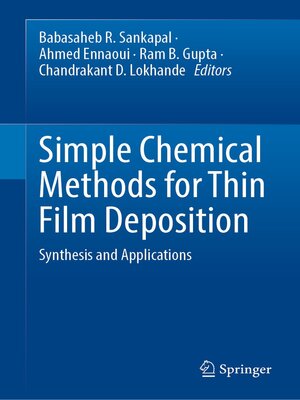Simple Chemical Methods for Thin Film Deposition
ebook ∣ Synthesis and Applications
By Babasaheb R. Sankapal

Sign up to save your library
With an OverDrive account, you can save your favorite libraries for at-a-glance information about availability. Find out more about OverDrive accounts.
Find this title in Libby, the library reading app by OverDrive.



Search for a digital library with this title
Title found at these libraries:
| Loading... |
This book explores chemical methods for thin film deposition with diverse nanostructured morphology and their applications. Unlike top-down techniques, chemical methods offer low cost, simplicity, and growth of nanostructured surface architecture with ease of small to large-scale area deposition. The book primarily focuses on innovative twelve chemical methods for thin-film deposition on one platform. Since each method has its own advantages and disadvantages, it is crucial to select the specific method for specific material to be deposited depending upon what type of application is targeted. Due to inclusive of diverse chemical deposition methods, researcher will have knowledge about best choice of the deposition method to be adopted. Inclusive methods discussed in the book are chemical bath deposition, successive ionic layer adsorption and reaction, ion exchange, electroless deposition, electrodeposition, hydrothermal, spray pyrolysis, spin coating, dip coating, doctor blade, screen printing, and sol-gel.The selection of the correct procedure for material to be deposited in thin film form depends on its unique process parameters based on the kind of application and its requirement. The role of preparative factors necessary for thin film alters properties related to structure and surface morphology, electrical conductivity and optical band gap which have been extensively discussed along with the underlying science of film synthesis. The book provides a comprehensive overview of the field of chemical methods for thin film synthesis to applications. In addition to synthesis, the book covers characterization, instrumentation, and industrial application of thin films. As a result, concentrated techniques will be of great interest to university/college professors, students and new engineers as well as postdocs and scientists in the area.






